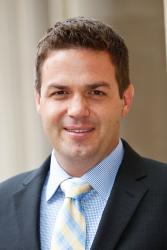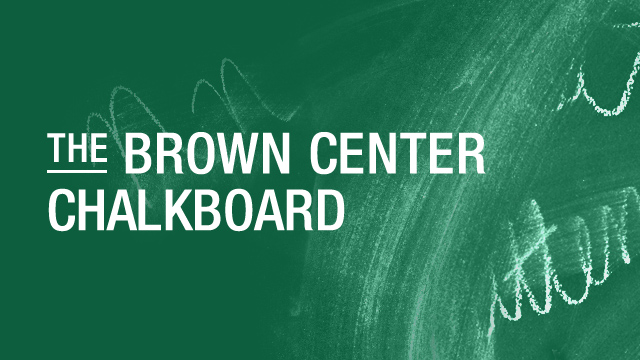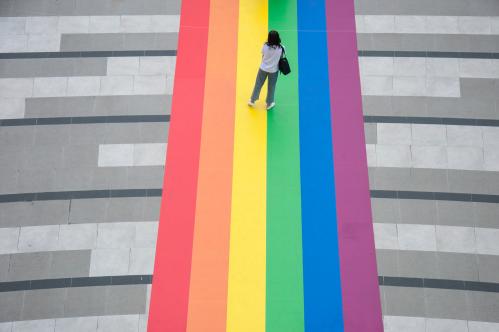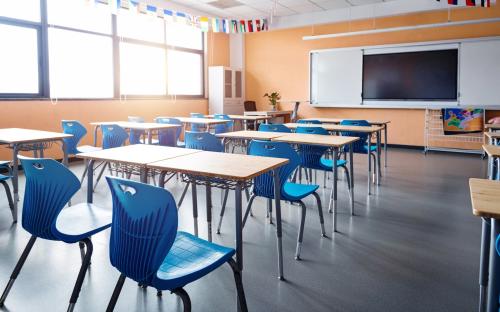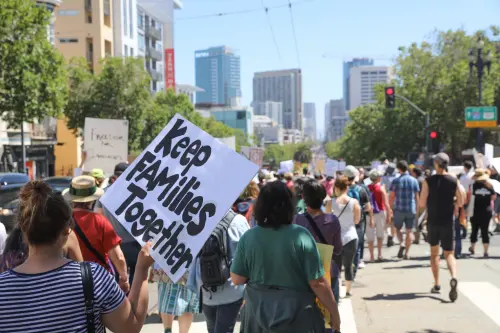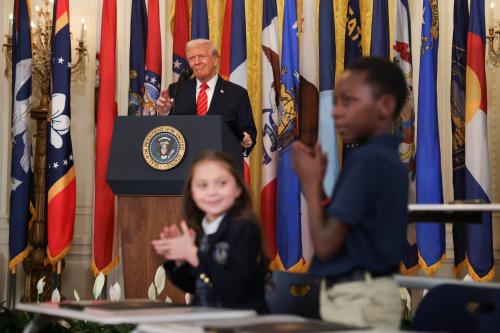President Trump’s return to the White House portends an intensification of culture wars in the classroom. In the six weeks since his inauguration, Trump has issued multiple executive orders affecting students and young people in pursuit of his agenda. Many of these orders are expected to attract legal challenges as they counter prior congressional and judicial decisions; though in the meantime, Trump’s flurry of actions are creating new pressures on schools.
The LGBTQ+ community, and especially transgender individuals, are among the key targets of these recent actions. The rapidly shifting political and legal climate not only impacts LGBTQ+ students in schools but also may adversely impact their teachers, especially those who identify as LGBTQ+ themselves. This post investigates research and data on LGBTQ+ K-12 teachers in American schools. This review of the evidence offers a window to consider how some teachers may be personally impacted by the further encroachment of culture wars into the classroom.
In summary of our findings, the K-12 teacher workforce has a higher share of individuals who identify as lesbian, gay, or bisexual than the general adult population we compare against, using the most recent national data available. Further, the research on LGBTQ+ teachers suggests they may be an important resource for otherwise marginalized students, and all teachers could benefit from training to help them create supportive learning environments.
LGBTQ+ rights are being newly challenged after a decade of advances. The U.S. Supreme Court’s Obergefell v. Hodges decision (2015) legalizing same-sex marriage nationally was widely seen as a watershed moment for the LGBTQ+ community. A less prominent, though just as important, Supreme Court decision, Bostock v. Clayton County (2020), extended federal employment and nondiscrimination protections to all LGBTQ+ individuals. But the tides of public acceptance of LGBTQ+ individuals and their rights, which had been steadily increasing for decades, have begun to turn back in recent years, especially among Republican voters.
Even before Trump’s win last November, LGBTQ+ issues were subject to fresh policy scrutiny. According to the ACLU, 2024 was a record year for anti-LGBTQ+ legislation introduced, with 18 bills that curtailed LGBTQ+ students’ or educators’ rights signed into law. The content of these laws ranged from forcing schools to out LGBTQ+ students to parents to preventing transgender individuals’ access to public accommodations. Conflicting court decisions over the last year and Biden-era Title IX interpretations over transgender students’ rights have also left schools unsettled.
These policy shifts have impacted teachers, too. According to a 2023 RAND survey, more than a third of teachers worked in states with restrictive laws on the discussion of controversial topics in the classroom (including LGBTQ+ issues). GLSEN, an advocacy group of educators supporting LGBTQ+ students, report that many LGBTQ+ teachers have perceived discrimination from both peers and parents. They must walk a thin line between “pride and professionalism,” constantly aware that their personal and professional identities may sometimes come into conflict, with potentially negative consequences.
According to a recent Gallup survey, 7.6% of American adults identify with the LGBTQ+ community, with younger generations more likely to self-identify. Further, gay men and lesbian women hold higher levels of educational attainment than their straight counterparts. Since K-12 teaching requires a college degree and relies on a disproportionate share of young adults to lead classrooms, we might expect relatively strong LGBTQ+ representation among educators. Even more, a 2015 study exploring how people of different gender identities and sexual orientations sort into occupations concluded that occupations with high task independence, high reliance on social skills, and employing high shares of female workers (all of which describe K-12 teaching) were also more likely to attract both gay men and lesbian women.
To our knowledge, only one prior study—published by a team of RAND researchers as a working paper in January—attempts to estimate the share of K-12 teachers who identify as LGBTQ+ using nationally representative data. The authors concluded that LGBTQ+ individuals are less likely than non-LGBTQ+ people to work as K-12 teachers; though this contradicts the correlational relationships found in other research studies described above. The study’s drawback, though, is its reliance on two different national surveys that either reliably identified sexual orientation or occupation, but not both simultaneously.
Here, we have a similar goal of estimating the LGBTQ+ share among K-12 teachers, though we use nationally representative survey data that captures both occupation and sexual orientation in the same source. This is a noteworthy improvement over the most consequential drawback in the RAND analysis. And contrary to their findings, our results point to a higher LGBTQ+ share among teachers than non-teachers in the most recent data.
Specifically, we utilize the public-use version of the National Health Interview Survey, a survey administered regularly through the Center for Disease Control (CDC). Sexual orientation (including lesbian, gay, or bisexual; hereafter LGB) has been available in the public-use version of the NHIS data since 2015. Note that gender identity separately from sex was not reported in the public-use data, so our analysis cannot identify those who identify as transgender, queer, or any other identity. Thus, our estimates of the share of LGB among teachers should be considered a conservative estimate of the overall share of LGBTQ+ teachers.
Figure 1 shows the share of adults, aged 20 to 65, in the NHIS sample who identify as LGB in each of the survey waves collected between 2015 and 2023. The figure categorizes respondents into two mutually exclusive groups: those working as K-12 teachers versus a general adult sample (not working as K-12 teachers). In the 2023 survey, 8.7% of K-12 teachers identified as LGB, which was significantly higher than the 6% observed among the general adult population (observed differences between the groups are not statistically significant in earlier survey waves).
We cannot say whether the LGBTQ+ share among teachers is diverging from the general adult sample, though the visual trend seems to suggest as much. The NHIS survey methodology changed in 2019, which prevents direct comparison of pre- versus post-change data (the data visual also reflects this break in the series). Based on the survey documentation, this change was not obviously related to the collection of sexual orientation information, though there was a minor change in the item response’s wording. Both K-12 teachers and the general adult samples now report levels that are markedly higher than the survey waves collected before the change.
For comparison, we also calculated the LGB share in other occupations and present these in Table 1 using the 2023 survey wave only. Post-secondary teaching and nursing have often been used as comparison occupations for K-12 teachers in research studies. We also examine all other occupations in which at least 60% of respondents are female and calculate the LGB share among this group generally, along with the share of working adults employed in any non-teaching occupation. We find LGB representation among K-12 teachers (8.7%) is much lower than the observed share among post-secondary teachers (12.2%) but is roughly the same as that observed in other female-dominated occupations (9.0%) and more than two percentage points higher than the general working adult reference group (6.2%). These patterns generally corroborate the prior research on LGBTQ+ individuals’ education and occupations discussed earlier.
We were also interested in whether the rates of LGB K-12 teacher representation varies across geographic regions. The public-use NHIS data do not identify state or county of residence but do classify respondents’ locale by urbanicity measures. We found the share of LGB K-12 teachers is nearly twice as high in large central metropolitan areas (11.9%) versus those in non-metro areas (6.4%).
Prior research suggests that yes, having an LGBTQ+ teacher can have a positive impact on LGBTQ+ youth. This happens primarily through caring about LGBTQ+ students; providing positive role models and exposure to LGBTQ+ issues may also play a role. Unsurprisingly, LGBTQ+ teachers are more likely than non-LGBTQ+ teachers to report engaging in affirming and inclusive practices in schools, including practices like informally discussing LGBTQ+ topics with students or serving as an advisor to a Gay-Straight Alliance or similar student club. Though no study directly explores the relationship between LGBTQ+ teachers and student academic outcomes, students’ feelings of belonging and inclusion are consistently shown to be positively correlated with many academic and non-academic outcomes. It seems reasonable to expect that LGBTQ+ teachers’ impacts on student belonging could translate to other outcomes, even if direct evidence does not yet exist.
We must caution that the evidence base for LGBTQ+ teacher relationships is quite weak. The emerging field heavily relies on exploratory research methods (e.g., qualitative interviews and non-representative surveys). Also, many studies are funded or produced by advocacy organizations. Despite these drawbacks, the evidence base does offer suggestive evidence that echoes the theorized relationships seen for racial/ethnic matching between students and teachers, which rests on a much stronger evidence base.
There is also a documented student need for the inclusion that LGBTQ+ teachers offer. Based on the most recent Youth Risk Behavior Surveillance System, the share of middle and high school students who identify as LGBTQ+ was 25% in 2023. And according to the Trevor Project, an advocacy organization for LGBTQ+ youth, many LGBTQ+ youth now report self-identifying and coming out earlier in life, with nearly a quarter coming out to peers before age 13. LGBTQ+ youth report higher rates of victimization, compared to non-LGBTQ+ youth, for a variety of harms including bullying and sexual assault. They also report higher levels of anxiety, depression, and suicidality. Most of these negative outcomes are reported at much lower frequencies among LGBTQ+ youth who feel safe at school. Just over half of LGBTQ+ youth report feeling affirmed in school (second only to 68% feeling affirmed in online spaces), which leaves plenty of room for schools to make more students feel welcome.
We acknowledge that mixing LGBTQ+ issues and schools is a thorny issue politically—public opinion is divided and legal decisions affecting students are still making their way through courts. These factors should warrant caution in making policy changes.
Yet the recent spate of executive orders and anti-LGBTQ+ bills create new perils for LGBTQ+ teachers. Despite their constitutionally protected employment rights, LGBTQ+ teachers could now be at risk for merely acknowledging their sexual orientation or non-conforming gender identity. These policy moves may also discourage vulnerable LGBTQ+ students who may earnestly need support from seeking it in a relatively safe place—encouraging them to seek refuge in more affirming (but arguably not as helpful) spaces online.
Rather than stigmatizing both LGBTQ+ teachers and students, we argue that better training for teachers (whether LGBTQ+ or not) to lead difficult conversations in the classroom will be more productive in fostering a respectful learning environment. In fact, a solid majority of parents of school-age kids are also supportive of thoughtful discussions of LGBTQ+ issues in high school classrooms (though only a minority support such conversations among elementary-age students). Yet, according to GLSEN, most teachers do not feel confident about respectfully engaging with LGBTQ+ issues in the classroom; when teachers have received explicit training about such issues, most was related to discussing diverse family structures only and not about LGBTQ+ history or contemporary issues.
Critically, teachers do not have to be LGBTQ+ to create a supportive learning environment. Teachers’ attitudes toward the LGBTQ+ community and their willingness to intervene against anti-LGBTQ+ rhetoric (most often originating from students) can influence the school culture. Conversely, vague prohibitions against LGBTQ+ speech in schools may further chill the environment for teachers to intervene, enabling those who use anti-LGBTQ+ insults to bully others by removing needed checks on their behavior.
Stressors abound for K-12 teachers trying to help students recover from the pandemic. These new anti-LGBTQ+ policies make their workplaces even more challenging, at least for the sizable minority of teachers who identify as LGBTQ+. Rather than squashing what may be necessary and supportive speech to create respectful learning environments for all students in schools, we encourage a greater focus on helping to prepare teachers to address controversial topics with respect in the classroom.
The Brookings Institution is committed to quality, independence, and impact.
We are supported by a diverse array of funders. In line with our values and policies, each Brookings publication represents the sole views of its author(s).
